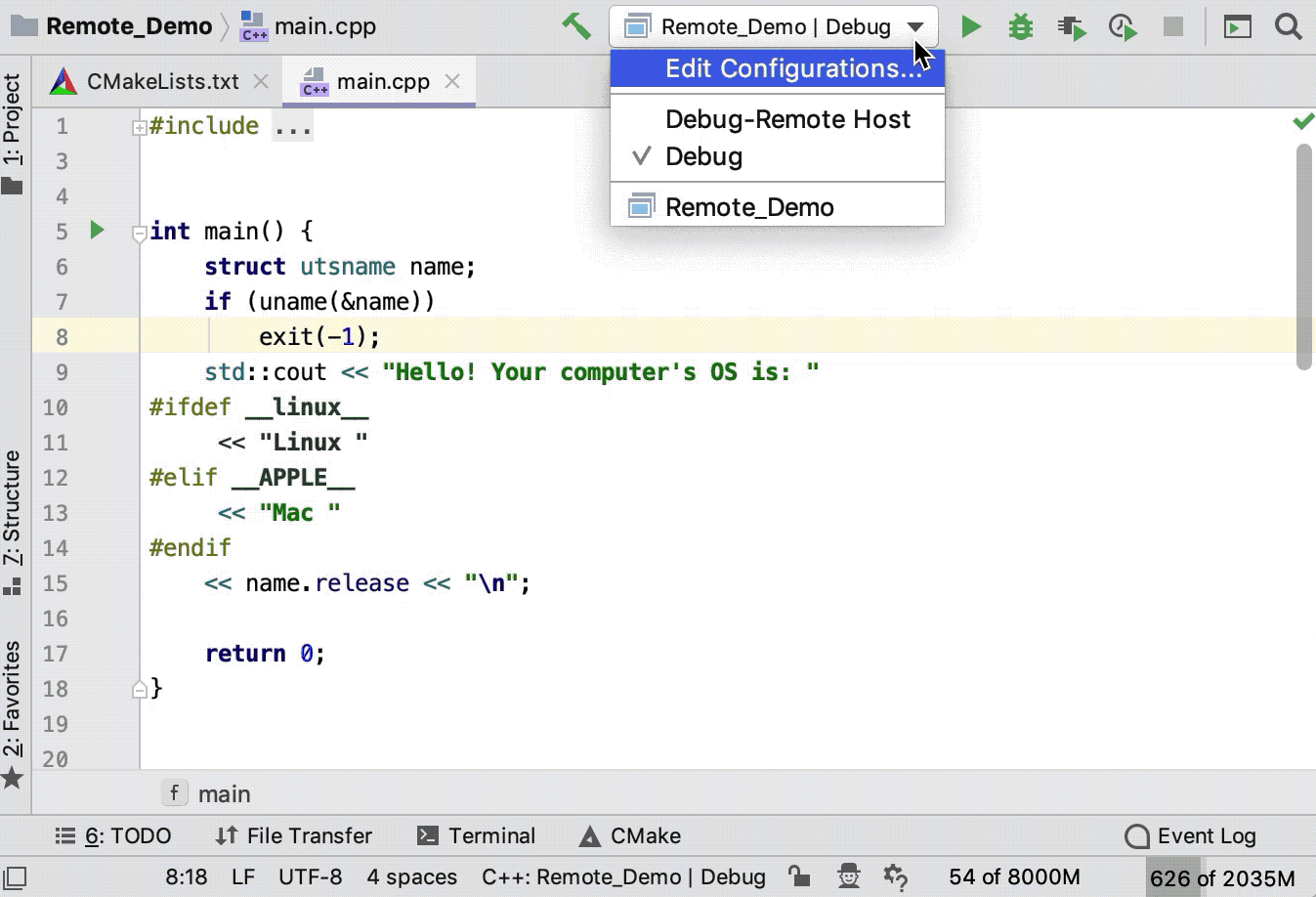

- #CLION FULL REMOTE HOW TO#
- #CLION FULL REMOTE UPDATE#
- #CLION FULL REMOTE CODE#
- #CLION FULL REMOTE WINDOWS#
rsync can be installed on WSL.Ī: For WSL it’s better to use a separate WSL toolchain type.
#CLION FULL REMOTE WINDOWS#
Q: For remote development on Windows with WSL, can we have rsync to transfer the files? It will be much faster than scp. When configuring the remote toolchain, select the “Key Pair” authentication type. The setup is also limited in terms of the project model, as right now it works only for CMake.Ī: Yes, they are supported. Q: What are the supported combinations of platforms for the Full Remote Mode?Ī: The local client machine can be macOS, Linux, or Windows, but the remote host should be Linux. The latest is not yet available in CLion, but we definitely have some plans for the future – see CPP-13751. Q: What if the remote is a Docker container? Can this be handled somehow similar?Ī: While you can work with Docker containers as with regular remote machines now (so the Full Remote mode will work), you might be asking about smarter support, which includes Docker toolchains and some easy configuration steps (like we have for WSL now). Stay local, let your IDE do remote work for you! – blog post on Full Remote mode in CLion.Documentation page on using WSL development environment in CLion.Documentation page on Remote Debug via GDB/gdbserver.In this webinar, we took a look at some of the remote development topologies that developers work with, explaining how CLion supports them.Ġ1:06 – Intro with all the topologies briefly explainedġ5:37 – Raspberry Pi demo: remote GDB debugĢ6:00 – Raspberry Pi demo: full remote mode Close configuration window.The recording of our February 28th webinar with Phil Nash is now available on the JetBrainsTV YouTube channel.

Please navigate to the “Peripheral” tab in a “Debug” view, press the “Configure” iconĪnd select registers to monitor. Please select PlatformIO DebugĬonfiguration and press the “Debug” button: Peripheral Registers ¶ “PlatformIO for CLion” supports Debugging which allows you to debug yourĪpplication with 1-Click without extra steps. Please note that you need to manually close/stop device monitor before firmware uploading. You can also configureĭevice monitor per project using Monitor options. Please open CLion terminal and use Device Manager CLI. Select PlatformIO Upload configuration and use the “Build” button for projectĬompilation or the “Run” for a firmware uploading: Remove pre-task (“Build”) from PlatformIO Upload and PlatformIO DebugĬonfigurations to avoid double project building. PlatformIO Debug configurations (you can add the rest configurations if you need them): Open project configuration wizard and add PlatformIO Upload and */ #include "Arduino.h" // Set LED_BUILTIN if it is not defined by Arduino framework // #define LED_BUILTIN 13 void setup () Build & Upload ¶ ** * Blink * * Turns on an LED on for one second, * then off for one second, repeatedly. Rename main.c file in src folder to main.cpp (right click on a file Please USE ONLY Latin characters (a-z) in a project name toĪvoid further issues with project compilation. Please open “New Project” wizard, select board and framework, and create a new
#CLION FULL REMOTE HOW TO#
Have a general understanding of how to work with projects in the CLion IDE. You a creation process of a simple “Blink” example. This tutorial introduces you to the basics of PlatformIO for CLion workflow and shows Intermediate CMakeLists.txt, but there is no ETA for this feature. At the moment we’re working on better integration with CLion without this Because of this approach, there is a conflict betweenĬMakeLists.txt used by ESP-IDF and CMakeLists.txt which PlatformIO generatesįor CLion. Provide more seamless integration, PlatformIO uses the CMake file-based API to extractīuild configurations. Starting with version 4.0, ESP-IDF uses a build system based on CMake. See how to Convert Arduino file to C++ manually. As a result, itĭoesn’t support the Arduino files ( *.ino and.
#CLION FULL REMOTE CODE#
ino files are not supported ¶ĬLion uses “CMake” tool for code completion and code linting. Press “+” button and PlatformIO-based project profiles: Arduino. Please open CLion Settings and navigate to “Build, Execution, Deployment > CMake”. This is a known issue CLion CPP-19478: CLion does not handle “CMAKE_CONFIGURATION_TYPES” from CMakeLists.txt.Ī temporary solution is to manually configure project profiles in CLion.
#CLION FULL REMOTE UPDATE#
Update CLion configuration: “Tools > PlatformIO > Re-Init” CLion does not load project build environments from “platformio.ini” ¶ There is a feature request CLion #CPP-18367: Follow platformio.ini changes and update the project. Please note that “PlatformIO for CLion” plugin does not update automatically CLionĬonfiguration.


 0 kommentar(er)
0 kommentar(er)
